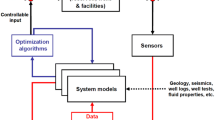Abstract
In gas condensate reservoirs, gas flow at large velocities enhances the gas permeability due to gas-liquid positive coupling which results in near-miscible flow condition. On the other hand, augmented pressure drop due to non-Darcy flow, reduces the gas permeability. Models for the “Positive Coupling” or “non-Darcy flow” include several parameters, which are rarely known from reliable lab special core analysis. We offer a good alternative for tuning of these parameters in which the observed production history data are reproduced from the readjusted simulation model. In this study, history matching on observed production data was carried out using evolutionary optimization algorithms including genetic algorithms, neighborhood algorithm, differential evolution algorithm and particle swarm optimization algorithm, where a faster convergence and lower misfit value were obtained from a genetic algorithm. Then, the “Neighborhood Algorithm–Bayes” was used to perform Bayesian posterior inference on the history matched models and create the posterior cumulative probability distributions for all uncertain parameters. Finally, Bayesian credible intervals for production rate and wellhead pressure were computed in the long-range forecast. Our new approach enables to not only calibrate the gas effective permeability parameters to dynamic reservoir data, but allows to capture the uncertainty with parameter estimation and production forecast.


















Similar content being viewed by others
Notes
Condensate to Gas Ratio
References
Bush M, Carter J (1996) Application of A Modified Genetic Algorithm to Parameter Estimation in the Petroleum Industry. Intelligent Engineering Systems through Artificial Neural Networks (6), pp 397–402
Chen HL, Monger TG et al (1995) Determination of relative permeability and recovery for North Sea gas reservoir. SPE 30769
Christie M, Macbeth C, Subbey S (2002) Multiple history matched models for teal south, The Leading Edge, March, pp 286–289
Danesh A, Henderson GD, Peden JM (1991) Experimental investigation of critical condensate saturation and its dependence on interstitial water saturation in water-wet rocks, SPE-19695-PA
Eberhart RC, Kennedy J (1995) A new optimizer using particle swarm theory, Proceedings of the Sixth International Symposium on Micro Machine and Human Science, New York, NY, pp 39–43
ECLIPSE Simulation Software Manuals 2010.1 (2010) ECLIPSE Technical Description, Schlumberger
Erbas D (2007) Sampling Strategies for Uncertainty Quantification in Oil Recovery Prediction, PHD thesis, Heriot Watt University
Fernandez J, Echeverria D, Mukerji T (2009) Application of particle swarm optimization to reservoir modeling and inversion, IAMG09 conference, Stanford University, pp 23–28
Frooqnia A (2014) Numerical Simulation and Interpretation of Borehole Fluid-Production Measurements, Ph.D. Dissertation, The University of Texas at Austin, Austin, Texas
Frooqnia A, A-Pour R, Torres-Verdín C, Sepehrnoori K (2011) “Numerical simulation and interpretation of production logging measurements using a new coupled wellbore-reservoir model”, paper VV presented at SPWLA 52nd international logging symposium. Colorado Springs, Colorado, pp 14–18
Frooqnia A, Pishvaie MR, Aminshahidy B (2014) Real-time optimization of a natural gas lift system with a differential evaluation method. Energy Sources Journal, Part A: Recovery, Utilization, and Environmental Effects, 36(3):309–322. https://doi.org/10.1080/15567036.2010.540631
Gelman A, Carlin JB, Stern HS, Rubin DB (1995) Bayesian data analysis, 1st edn. Chapman and Hall, London
Hajizadeh Y (2011) Population-Based Algorithms for Improved History Matching and Uncertainty Quantification of Petroleum Reservoirs, PHD thesis, Heriot Watt University
Ham, J.D. and Eilerts, C.K.(1967) Effect of saturation on mobility of low liquid-vapor ratio fluids, SPEJ 11–19.
Henderson GD, Danesh A et al (1998) Measurement and correlation of gas condensate relative permeability by the steady state method. SPE 30770
Holland J (1975) Adaptation in natural and artificial systems. MIT Press, Cambridge
Kathrada M (2009) Uncertainty Evaluation of Reservoir Simulation Models Using Particle Swarm and Hierarchical Clustering, PhD Thesis, Institute of Petroleum Engineering, Heriot Watt University, Edinburgh, UK
Mohamed L, Christie M, Demyanov V (2009) Comparison of stochastic sampling algorithms for uncertainty quantification, SPE 119139, Reservoir Simulation Symposium, The Woodlands, Texas, USA, 2–4 February
Mott R, Cable A et al (2000a) Measurements and simulation of inertial and high capillary number flow phenomena in gas-condensate relative permeability. SPE 62932
Mott R, et al (2000b) Measurements of relative permeability for calculations gas condensate well deliverability, SPE–68050–PA
Nicotra G, Godi A, Cominelli A, Christie M (2005) Production data and uncertainty quantification: A real case study”, SPE 93280, reservoir simulation symposium, Houston, USA, 31 January-2 February
Oliver DS, Reynolds AC, Liu N (2008) Inverse theory for petroleum reservoir characterization and history matching, 1st edn. Cambridge University Press, Cambridge
Rotondi M, Nicotra G, Godi A, Contento F, Blunt M, Christie M (2006) Hydrocarbon production forecast and uncertainty quantification: A field application, SPE 102135, Annual Technical Meeting and Exhibition, San Antonio, USA, 24–27 September
Sambridge M (1999a) Geophysical inversion with a Neighbourhood algorithm, part 1: searching parameter space. Geophys J Int 138:479–494
Sambridge M (1999b) Geophysical inversion with a Neighbourhood algorithm - II appraising the ensemble. Geophys J Int 138:727–745
Storn R, Price K (1995) Differential evolution – A simple and efficient adaptive scheme for global optimization over continuous spaces, technical report for international computer science institute, Berkeley, TR-95-012
Valjak M [2008] History Matching and Forecasting with Uncertainty, Challenges and Proposed Solutions for Real Life Field Application, PhD Thesis, Institute of Petroleum Engineering, Heriot Watt University, United Kingdom
Watson AT et al (1986) A new algorithm for automatic history matching production data. SPE 15228
Author information
Authors and Affiliations
Corresponding author
Additional information
Editorial handling: Liang Xiao
Appendix
Appendix
Rights and permissions
About this article
Cite this article
Dermanaki Farahani, Z., Ahmadi, M. & Sharifi, M. History matching and uncertainty quantification for velocity dependent relative permeability parameters in a gas condensate reservoir. Arab J Geosci 12, 454 (2019). https://doi.org/10.1007/s12517-019-4603-x
Received:
Accepted:
Published:
DOI: https://doi.org/10.1007/s12517-019-4603-x




